The treasury of James V left an extensive archive with the treasurer’s accounts and exchequer rolls. In addition there are two series of household books and inventories of household goods. Much of the building work on royal palaces is also well documented, with the survival of volumes produced for audit by the Master of Work, John Scrimgeour of Myres, who also came to have responsibility for collecting tax money allocated to the building projects. [1]
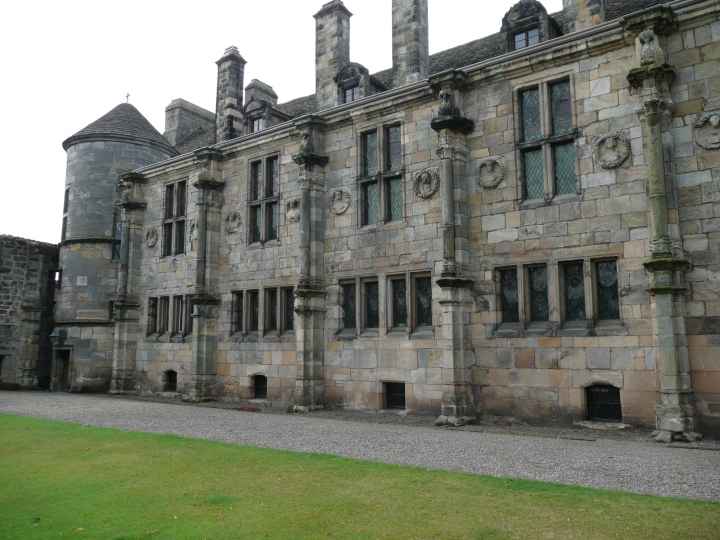
Falkland Palace, the South Quarter Façade.
However, the building of Stirling Palace is not well represented in the archives. Although the treasurer’s account records payments to the three masters of work, the priest James Nicholson, the carpenter Robert Robertson and the aristocrat Sir James Hamilton of Finnart, who was master of the royal works, no detailed record of their expenditure survives. Nicholson and Robertson would have submitted short accounts to the treasury that were not deemed worthy of preservation. Hamilton of Finnart’s works were mainly financed by an unusual arrangement whereby he directly controlled and financed the building work, and was to receive remuneration in the form of charters for his acquisition of lands, particularly in Avendale and Strathaven.
In July 1540, shortly after completing an unspecified milestone in the construction of the palace, and receiving his rewards, Finnart was executed. A chest with his evidences was carried from his Craignethan Castle to Edinburgh. A document amongst the charters of the House of Binns narrates that his papers in the hands of crown officers were ‘rekkeslie tynt’. These papers presumably included his records of the palace works.
Such records would not have shed complete light on the construction and design of the palace or supplied a recipe book for the reconstruction of the interior. Finnart’s surviving account for his work at Linlithgow 1534-5 does not reveal much about the palace. Answers, if any, to questions about the art and architecture of the palaces lie elsewhere. While names of the craftsmen and exact timetable of Stirling’s palace construction are lost, something of the contents is known from inventories, and the function and life of the Palace may be re-created from books of household expenses and other sources The personnel and backgrounds of the craftsmen and artists at court are glimpsed in the records of James V’s other buildings.
While French artistic influence seems paramount, the clearest direct artistic influence on the place were engravings by the Nuremburg artist Hans Burgkmair, which must have been in the hands of the sculptor of some of the exterior statues. When James married Madeleine of Valois in January 1537, he acquired the guns of Dunbar, and two ship loads of luxury goods. His purchases in France included the tapestries of the City of Ladies, the Creation of the World, and the Old and New Testaments, popular subjects ready-made in Flemish centres, and in themselves a mine of visual reference. There had been time for him to commission pieces in Paris; an embroiderer, Mathurin Moreau, worked cloths for the king’s mules with the royal arms, and goldsmiths in the workshop of Hotman made silver plate. Cardinal Beaton had supervised the purchase of cloth-of-gold from Lyon for his wedding outfit. When James was leaving, one of Hotman’s sons had to ride with the last finished pieces to the ships. With his tapestries, new beds and rolls of luxury fabric, James sailed with a ‘tapisier,’ Guillaume, to fabricate and manage these complex textile constructions, and Guillaume brought his wife and children.
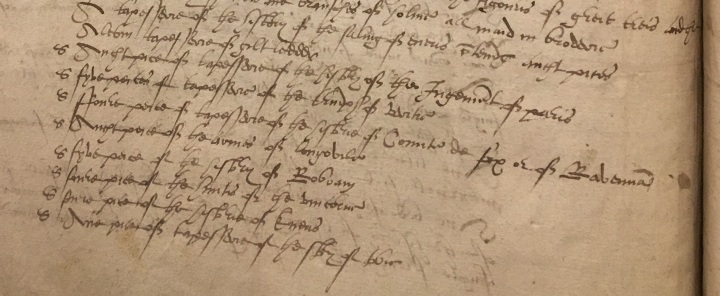
Suites of tapestry hanging at Stirling in 1578, BL Harley 4637 f.143v.
James V spent nearly a year in France, but it would be wrong to overstate this personal experience as if continental culture were a novelty. Since his personal rule began in 1529, James employed foreign craftsmen, just as his guardian John Stewart, duke of Albany had in the previous decade. James commissioned prestigious objects abroad, and had begun an architectural programme unparalleled in Scottish history. A few letters mention purchasing of luxuries; Albany and Cardinal Beaton bought silver, exotic pets, weapons and costume. James’s secretary, Thomas Erskine of Haltoun, who travelled several times to meet Albany and negotiate the royal marriage, was involved in this kind of procurement.
Few if any of these objects survive, and exchequer accounts are vague where purchases of art are recorded, usually only giving the names of the Scottish agents. There is a contract made on 7 May 1530 for a tapestry or embroiderered altar frontal. Two Scottish intermediaries, the priest Duncan Burnett and merchant John Atkinson, discussed patterns and inscriptions with a Bruges maker, Francis Crayloot. Neither was directly employed by the royal court. Duncan Burnett later enjoyed the ecclesiastical patronage of Cardinal Beaton. Atkinson is less conspicuous in the records, but was involved in the cloth trade, and may well have been a connection of Mavis Atkinson, the wife of John Tennent keeper of the wardrobe.
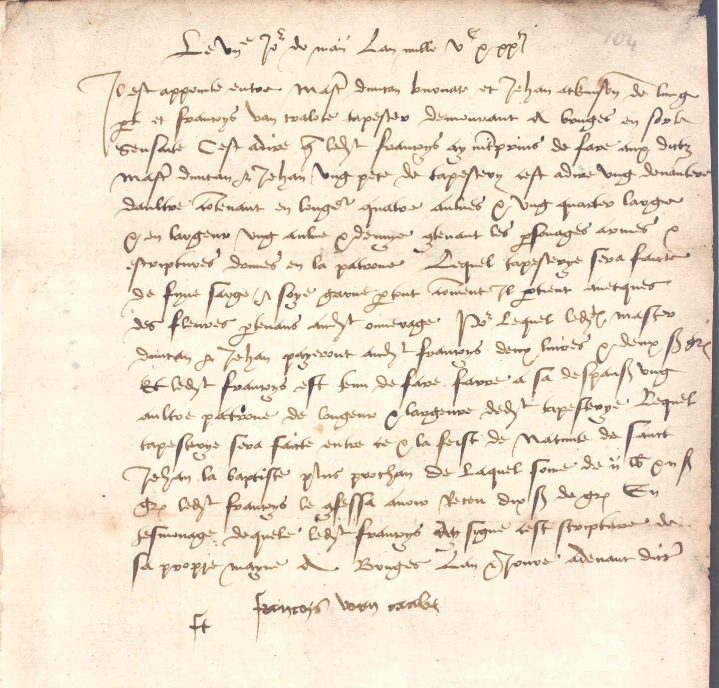
Contract with Francois Van Cralot for an altar frontal, NLS Adv. MS 29.2.5 f.104.
The altar frontal was to be made according to the agreed pattern and size, worked with silk and fine serge with personages, arms, and inscriptions. Crayloot promised to make another of the same size, which was 4 1/4 by 1 ½ ells, presumably Flemish ells, though the contract is in French. The work was to be finished before the next year’s feast of the nativity of John the Baptist, on 24 June 1531. The Crayloot family were well established as embroiderers and tapestry makers in Bruges in the sixteenth century, and can be connected with the Adornes family and the Jerusalem Chapel.
There is no corresponding payment for the embroidery in the treasurer’s accounts, but the king’s almoner, Master James Scrimgeour, was instructed to buy £2,000 worth of goods in Flanders in that year including munitions and ‘tapeitts,’ and this work was probably just one item on his list. One of the most important pieces of the puzzle is still missing. We do not know who made the decision to commission this altar frontal and why this had become a priority.
The agency of Mary of Guise is more apparent in later purchases, buying upholstered chairs in Paris and in 1559 Guise sent a Scottish merchant to Flanders to buy textiles, thread for embroidery, and paintings according to her written schedule. These paintings were fixed in a frame for the Chapel Royal at Holyrood Palace by Andrew Mansioun , a French carpenter, carver, and gunner in the royal artillery.
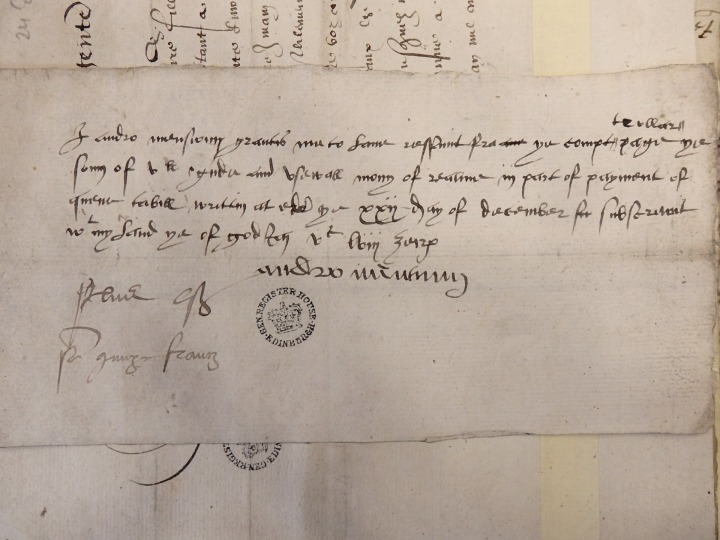
Andrew Mansioun’s receipt for payment for the ‘table’ in 1559, NRS E25/1/12.
Andrea Thomas notes a comment on the French marriage trip in one 16th century Scots version of Lesley’s history; that French fashions adopted at court and among the nobility were comely and beautiful, but more costly than the substance of the realm of Scotland could bear. As Thomas points out, had James’s reign been longer, his investment at the time of his marriages may have been proportionate. The comment is not in Lesley’s Latin and he concludes his life of James V with praise of his fiscal management. Moreover, James was constrained to spend on his palaces because Stirling and Falkland, furnished as royal houses, were part of the jointure promised to his queen if he were to predecease her.
When James V married Mary of Guise in 1539, David Beaton commissioned silver plate from Jehan Hotman, and more French craftsmen established themselves in Scotland. It is interesting to note that some of these men appear to have been young, and perhaps not long out of their apprenticeships. Guise arrived in a hired fleet of three galleys, the Saint Jean, Saint Pierre, and the Realle, and it may be that some of this new intake of craftsmen are named in the account for fitting out the ships and the long lists of sailors and men-at-arms that mostly comprised the manifest. Others were recruited by the new queen’s parents, who understood that James required an armourer, miners, and masons.
Contemporary literature was glowing on the subject of royal employment of foreign skilled labour. Hector Boece praised James I as a patron, looking back to his description of a Scotland deliberately denuded of talent during the Wars of Independence. William Stewart put Boece’s Latin into verse for the young James V;
That samin tyme, as it wes richt weill kend,
This nobill king into Ingland he send,
In France and Flanderis, all the lands socht
For craftismen in Scotland that he brocht,
Quhilk in all craftis that war richt perfyte,
That eftirwart, as my author did wryit.
To sindrie Scottis did thair craftis ken,
That sone efter war perfyte craftismen.
For, sen the tyme of Alexander the thrid,
Craftis in Scotland war baith tynt and hid,
Throw weir always and mekle oppin wrang
Into Scotland, that vexit wes so lang.
Syne ilk craft, of all baith moir and les,
To greit perfectioun dalie did incres.
James I seems to have employed a Florentine glazier, and bought Flemish tapestries and his major work was the Charterhouse of Perth; but these lines were probably inspired by observation of royal secular and ecclesiastical works under James IV and Albany. In 1527 Albany was noted ‘conducing’ French masons for Dunbar Castle. Boece may have been thinking of Albany’s masons at Dunbar, his use of French joiners or the Italian who made bricks for the furnaces of his gun founding works. Advice to build the domestic economy with foreign talent was reiterated by Robert Lindsay of Pitscottie when he reflected on the more settled aspects of the reign of the fifth James;
he plenished the country with all kind of craftsmen out of other countries, as Frenchmen, Spaniards, Dutchmen, and Englishmen, which were all cunning craftsmen, every man for his own hand. Some were gunners, wrights, carvers, painters, masons, smiths, harness-makers, tapesters, broudsters, taylors, cunning chirugeons, apothecaries, with all other kind of craftsmen to apparel his palaces
Foreign craftsmen were employed directly by the court in connection with building, the royal artillery, or both. Before the king’s marriage there were already French, German, and Flemish gunners, but key posts were filled by Frenchmen after his marriages, joining more established locals, such as the long-serving carpenter and supervisor John Drummond of Milnab (fl. 1505-1550).
In December 1547, Henry Stewart, Lord Methven, as master of the Scottish artillery, would advise Mary of Guise to seek expert military men from abroad to besiege Broughty Castle, saying that Arran could easily have taken St Andrews Castle with better advice. Evidence of Scottish recruitment during the Rough Wooing comes from an unlikely source. Henry VIII had a Moravian military engineer, Stefan von Haschenperg, who worked at Calais, and on the Scottish border at Carlisle. At first Stefan, a subject of Holy Roman Empire, was distrusted and his minders were instructed not to let him view the secrets of the English fortifications. His career then peaked but Stefan was sacked in 1543 after accusations of mismanagement at Carlisle. As part of his campaign to regain favour, Stefan sent letters informing on the work of Scottish recruiters in Antwerp who had made offers to an acquaintance of Stefan, the uncle of a plumber called Hans who was working on Henry’s fortifications at Hull.
The incident suggests a small international community of technical experts willing to travel to find employment at the courts of Europe. Stefan, like Master George’s family was versatile and adaptable; beyond his designs for artillery fortifications characterised by Martin Biddle as ‘horrifyingly over-complex’, he began to build a novel watermill at his own estate in London, proposed to bring water for a fountain at Nonsuch palace, claimed chemical knowledge for refining metals and manufacture, and spoke and wrote several languages. Hamilton of Finnart may have employed such an expert for his buildings and fortifications, his mining and the fountain at Linlithgow Palace. As opportunity arose, the French woodcarver Andrew Mansioun would demonstrate a surprising range as an artist in wood and metal, an engineer, a supervisor of furnture-making apprentices, and a hero under enemy fire.
James V acquired some craftsmen as a direct result of his second French marriage. In December 1538, the Duke and Duchess of Guise arranged for miners, an armourer, and a team of masons to be sent into Scotland. It is possible that Claude, Duke of Guise obtained some of these men from his brother, the Duke of Lorraine in Nancy. If so, these men may have been tokens in exchange for Scottish riding ponies sent to the gouty Duke Antoine.
These men arrived in July 1539. The miners spoke no Scots, and found little to do in the lead mining area of the western border. Although the goldsmith John Mossman supervised the making of refining equipment for them in Edinburgh, they stayed only for two months. Perhaps an interpreter was needed because they were German speakers from the Duke of Lorraine’s silver mines: John Lesley, writing in the 1570s, discussed a group of German miners in Clydesdale and Crawfordmuir. His emphasis on their unusual and secret technique for refining the purest gold may refer to this group and the apparatus made by Mossman.
Nicolas Roy, a stonemason, was set to work at Falkland Palace and given a permanent appointment as the king’s master mason. The masons at Falkland made two excursions to advise on the building of the Cardinal Beaton’s new college at St. Andrews. Although Roy is sometimes credited both with the finest carving and the renaissance façade design at Falkland, the building was in hand before he arrived. The Falkland accounts only mention sculptural stone carving by ‘Peter the Flemishman’. Roy was at Falkland while the shell of the Stirling Palace was being raised, but he probably joined the work at a later stage.
Another French craftsman who arrived around the same time was the woodcarver Andrew Mansioun. He is first recorded making furniture and fittings for the royal cabin on the yacht Unicorn, and made the cradle for James’s son. We do not know for sure if Mansioun was the leading carver or designer of the surviving portrait medallions. During the conservation of these oak roundels a drawing of freize with a baluster pendant was discovered on the reverse of head no. 29, perhaps intended for other carved ornament in the palace. Structural and other joinery at the palace was completed by Robert Robertson, who had worked on panelling at Falkland, and he became master of the palace work at Stirling in its final phases.
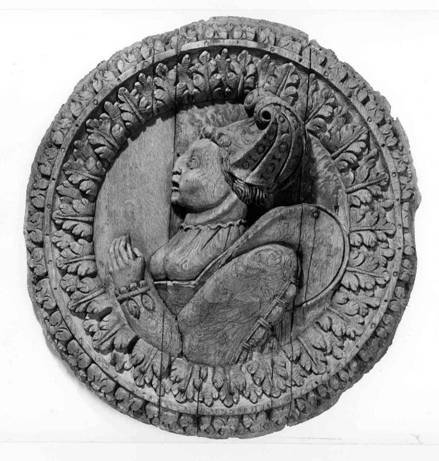
An oak ceiling roundel from Stirling Castle, Stirling head no. 29 (HES)
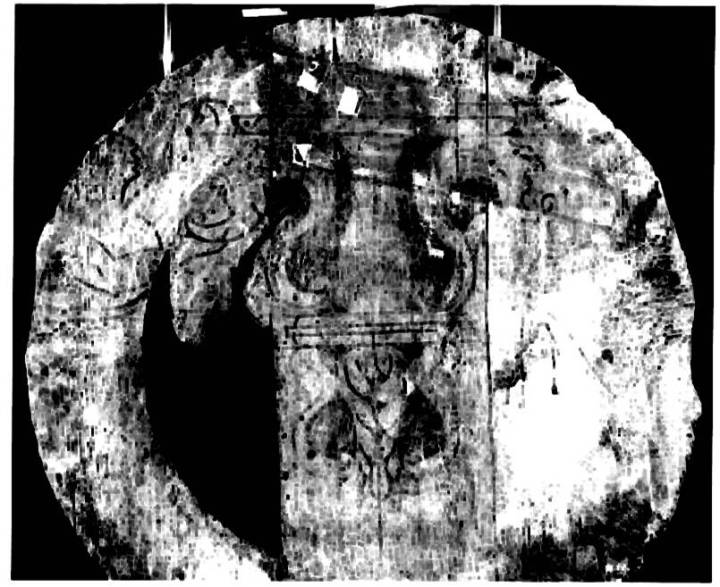
Drawing for carving on the back of Stirling Head’ no.29, (HES)
Mansioun also engraved metals, making a brass for the tomb of Cardinal Beaton’s parents at Markinch, and was later given a permanent appointment in the establishment of the royal gunners. There he made moulds for casting the royal arms and ciphers on cannons. Apart from the regular salary, other benefits were on offer; James V had paid for the sons of a French predecessor, Piers Rouen, to be trained as gunners in France. It is possible that Mansioun was the armourer mentioned by the Duchess rather than the other recorded Frenchmen who worked on arms and armour.
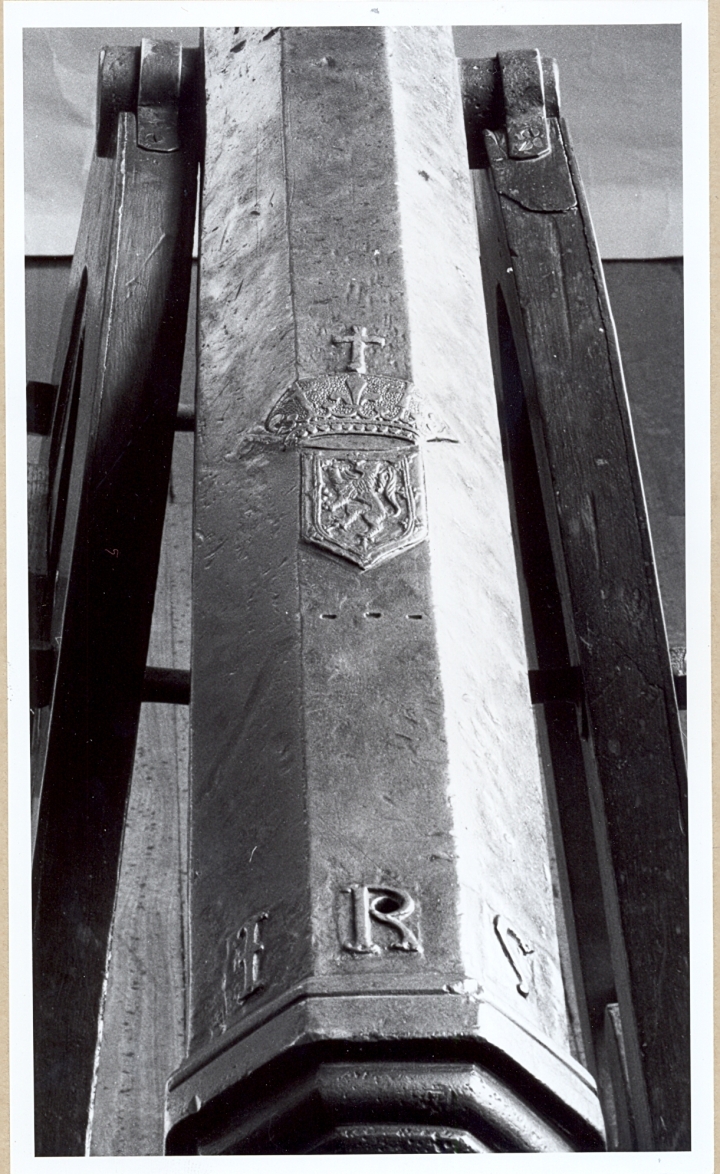
Cannon with cipher of James V, (Glasgow Museums)
Mansioun was prominent in the Edinburgh craft incorporation, his sons became burgesses of Edinburgh, and advised on the repair of the roof of St Giles, where their father had made new choir stalls in 1554. Other 16th century Scottish families connected with the castle gunners also made furniture; in 1562 James Stewart half-brother of Mary Queen of Scots had an oak bed made by Schang, a gunner and burgess of the Canongate.
It was important to appear self sufficient in armaments manufacture, and the gunners travelled to harvest native timber rather than rely on imports tied to international relations, though there was no shortage of wood shipped from Eastern Europe. Mansioun also travelled with John Drummond building winches and cranes for lifting guns and heavy materials, and freighting the cannon on ships at Leith and Dumbarton.
John Drummond made a loft for the chapel of Holyroodhouse in the Edinburgh Castle workshop and two lit-de-camp beds for the king. For his long service he was rewarded with lands, some in the Perthshire heartland of his family, and others at Ballencrieff, East Lothian, where other valued artillerymen had been given holdings. Drummond also maintained his family link to the exiled Douglases. He went to France with James V in 1536, and his comments on the relative popularity of Finnart and Angus during the royal marriage trips were sought after by Douglas agents, and eventually reported to the English court. Sensibly, he refused to be compromised by speaking directly to the Douglas’s chaplain at Dieppe while he was watching the king’s ships. The royal cannon and the busy foundry was a matter of royal pride and ostentation as much as a deterrent. Drummond was almost certainly the ‘Secret Friend’ of the earl of Angus who tried to impress on the English Berwick pursuivant, Henry Ray, the extent of the Scottish artillery works and the number of newly furbished guns. The accurate report which reached the English Privy Council tallies with the numbers recorded in Drummond’s own accounts.
When James V died, Andrew Mansioun carved the inscription for his tomb. Nicolas Roy and Pierre Quesnel the painter remained in Scotland attached to the court of Mary of Guise, and their names appear on a roll of the household. Nicolas worked on the walls and temporary fortifications of Stirling Castle, and made finishing touches to a kitchen within the palace, then went with one of gunners called ‘Cunningham’ to build fortifications in Carrick, Ayshire, or at Carrick Castle at Loch Goil in July 1544. [2]
In May 1544, John Drummond, Andrew Mansioun and the gunner and gun founder Hans Cochrane were in Edinburgh Castle during its brief siege by Lord Hertford’s army. The English military engineer Richard Lee judged the castle to be impregnable, in part due to its spirited artillery fire down the Royal Mile. An English cannon was disabled by the barrage in front of the castle and had to be destroyed and abandoned, and after a week of destruction in the town the invaders left on 15 May 1544.
Andrew Mansioun was hurt while firing cannon at the English. Regent Arran paid for surgery to his right hand, and he continued working in Scotland, and was given a permanent post as a gunner and increased salary on account of the injury. An example of his versatility is found in the record of construction work at the fortress island of Inchkeith, devised by Lorenzo Pomarelli, an Italian architect and military engineer. There he was probably in charge of a horse powered winch in the autumn of 1555, unloading Craigleith stone and lime shipped from Fisherrow. Some of the French colleagues listed in his team had been soldiers of Henri II’s garrison at Dunbar Castle.
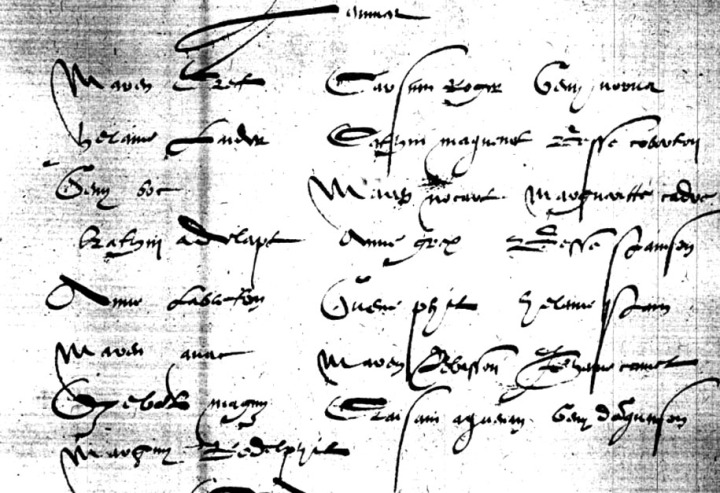
Women on Inchkeith Island, 1555, NRS E34/21/3 f.37r.
The majority of the personnel were Scots, and all are named, including the 120 labourers and a group of twenty two women who carried small stones called ‘moellon’. One of these women, Mary Greif, had a child with the mason John Duncan. The forty-five masons on Inchkeith were paid at various rates reflecting their skill, and some had been summoned by royal proclamation from their work at other places including Dirleton Castle.
This French military building operation was run on different lines to Scottish building work. The clearest difference is a class of foremen, called ‘solliciteurs’ paid much less that the Scottish master craftsmen and masons, whose duties included ‘making diligence’ and taking the roll call. It may be that equivalent supervision was expected of the individual masters on a Scottish building site. Even the labouring on Scottish sites was sometimes awarded by taskwork contract to gang-masters. In all the accounts of the Scottish master of works John Scrimgeour there is only slight evidence of any administrators and these officers were only concerned with payments and quantities rather than discipline. There is no evidence that the French work regime on the island was oppressive for Scottish men and women who served there although it may have required a little adjustment.
The account is also interesting as the most substantial surviving record of building work in the 1550s. Some of the men had worked at Holyroodhouse in the 1530s: two of the French soldiers were involved in the firework display at Stirling for the baptism of James VI in 1566, of these, Charles Bourdeaux was subsequently accused of a role in the Kirk o’Field explosion, and the other found a place in Morton’s army. Andrew Mansioun was promoted to John Drummond’s job as Master Wright of the Artillery during Mary’s personal reign. He died in 1579, and his son Francis had already taken his place as a gunner at Edinburgh castle. For more on Andrew Mansioun, see my article; ‘A French Furniture Maker and the Courtly Style’
Mansioun must have been around the same age as the painter Pierre Quesnel. A household account records him at Dunfermline Palace in the autumn of 1543 when Guise had moved on, with the tailor Guillaume Collimant and Marguerite Pignon, a lady of the chamber. They may have working on interior decoration there. [3] While the gunner was defending Edinburgh Castle, Quesnel took his leave of Scotland. He seems to be ‘his grace’s house painter,’ taking his pay for ten months work on 7 May 1544. Quesnel was an usher in the Queen’s household, a position with an annual salary of 80 livres tournois, and was paid for painter-work ad-hoc as the ‘Queen’s painter’, and latterly as the Regent’s house-painter. While his usher’s salary was small, it may have conveyed a great deal of prestige over other craftsmen. At the Scottish court the ushers of the chamber doors were often the younger sons of barons, and in France portrait painters were given similar positions and salaries. As an usher, Pierre was rewarded with £10 for his role at the coronation of Mary of Guise in 1540.
Some of the recorded work of the ‘queen’s painter’ was at Falkland Palace, apparently following the completion of joinery and panelling by Robert Robertson. The accounts give a list of pigments bought for this work. There are other payments for painting projects in the accounts, but their locations are not given. Throughout June and July 1542, the Queen’s painter was paid while Robertson was working on joinery at Stirling Castle, and so following the pattern seen at Falkland, it seems reasonable that some part of the interior of the palace was finished at this time, even if the whole building was still not complete.
When he returned to France, Pierre became a designer of tapestry and stained-glass as well as a portrait painter, the profession followed by his three sons. As a master-painter in Paris in 1561 he took on an apprentice jointly with a tapestry weaver. However only a couple of drawings are now attributed to his hand. As late as 1570, with his son François, he decorated a set of state rooms for the Bishop of Evreux in his priory at the Bois de Vincennes near Paris. The friezes of grotesques and arms around the rooms at the Priory of Bonshommes were painted with distemper painted on strips of linen pasted on the plaster walls. Pierre’s son François designed a tapestry cartoon for Mary of Guise’s sister, Renée of Lorraine, the Abbess of St Pierre’s convent in Reims. [4]
The family were keen to promote their Scottish connection as a unique selling point, and this ensured the preservation of the legend of Pierre’s time in Scotland more carefully than any of his works. In Scotland, Pierre had married a Madeleine ‘Digby’ or ‘Hideby.’ Her surname suggests she may have been a relative of one of tapestry workers in the Scottish wardrobe, William Edbe. Their sons became painters, and the eldest, François & Nicolas were born at Holyroodhouse. While Pierre was a minor artist perhaps only loosely connected with the French court, his sons enjoyed a higher reputation.
Several of their surviving portrait drawings were inscribed by early collectors mentioning their Scottish birth. This aspect of their heritage was recorded in the 17th century by Michel, Abbé de Marolles. The family history that informed Marolles and early collectors suggested an idea that ‘Quesnel’ was a Scottish name. A motto used on a portrait of François engraved by Pierre Brebiette plays on a popular etymology for Quesnel from ‘chesne’ or ‘chêne’ for oak, and with links of an iron chain, ‘Quo pedibus Ferri non queo mente Feror’. However, there was a Quesnel family established in the guild of painters and imagiers in Rouen in 1507; they were recorded working at Fontainebleau in 1536, and possibly at Troyes working for the Duke of Guise in 1532. Some of the painting at Fontainebleau was completed when James V visited in October 1536, and it seems most likely that Pierre came from this Rouen family.
The link of the surname to the French royal works must be set against Marolles’s remark that Quesnel was Mary’s gift to James V, implying that he, like Nicolas Roy, was recruited by the Guises. One of the queen’s professional embroiderers had been a servant of the Duchess of Guise. In 1540 he went to France and returned carrying letters from Antoinette. As the letters concerned the marriage of Mary’s sister, Louise de Lorraine, he may well have been recalled from Scotland to help complete decorations for the wedding.
One Scottish craftsman who spent most of working life at Stirling Castle was Sandy Loverance, who produced a set of bills forwork in 1559. He was anxious for payment, and had his account drawn up by a notary, which he presented to the Comptroller of the queen’s household, Bartholomew de Villemore. Sandy had managed the work of the glazier who repaired the windows of the palace, and a carpenter who built a ‘gardemange’ a travelling food cupboard for the Queen Regent.
In these bills Sandy’s name was written as if it were ‘Alexander La France,’ and so it had been thought he was yet another French craftsmen. His surname was probably nearer ‘Loverance’ – a name frequently recorded in the period especially in Linlithgow. From 1564 Sandy was paid an annual fee of £10 as master mason at Stirling, employed to look after the castle.
However, Sandy’s will shows that his apprehension of the Stewarts as bad payers was well-founded. His dues slipped out of view when the treasurer James Wishart of Pitarro rebelled against the marriage of Mary Queen of Scots to Darnley in 1565, and Sandy waited in vain for his money, totalling £285 pounds for the queen’s works at Stirling at the time of his death in 1575.
While looking at accounts gives a view coloured by pounds, shillings & pence, it is clear that these scraps of information on the biographies of craftsmen have the potential to shed light on the artistic influences at work in the 1540s and patterns of patronage. More detail may yet come to light, but it is already apparent that men like Andrew Mansioun led interesting lives and influenced craftwork and making in Scotland.
[1] H.M. Paton, Accounts of the Masters of Work for building and repairing Royal Palaces and Castles, vol, 1 (Edinburgh, 1957), 1-292.
[2] NRS E33/3 f.15, Nicolas Roy goes to ‘Karrick’.
[3] NRS E33/3/ f.29, Pierre Quesnel at Dunfermline.
[4] C. Grodecki,Cathérine, Documents du Minutier Central des Notaires de Paris: Histoire de l’art au XVIe siècle, 1540–1600, vol. 2, (Paris, 1986), 24, 203-204.
This post is based on a talk given at the Historic Scotland conference, ‘Rebirth of a Palace’ Stirling University, 26 November 2011.